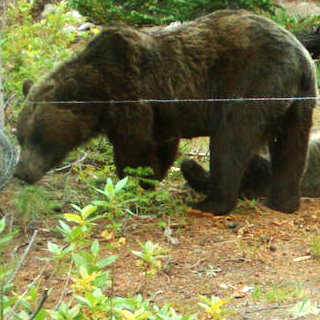Grizzly Bear Biology
Species Description
Grizzly bears (Ursus arctos horribilis) belong to the Order Carnivora and Family Ursidae. The grizzly bear is a member of the brown bear species (U. arctos) but the subspecies U. a. horribilis is only found in North America.
Grizzly bears are generally larger and more heavily built than other bear species. Grizzly bears can be distinguished from black bears by longer, curved claws, humped shoulders, and a face that appears concave. A wide range of coloration from light brown to nearly black is common. In the lower 48 States, male grizzly bears generally weigh between 400 and 600 lbs whereas females usually weigh between 250 to 350 lbs. Grizzly bears typically live to be around 25 years old.
Identifying Bears: Telling the difference between a grizzly bear and a black bear can be tricky. Size and color alone are not sufficient to make a positive identification. Learn how to tell the difference between black bears and grizzlies then test your knowledge at the Montana Fish, Wildlife, and Parks Bear Identification Website
Behavior
Grizzly bears are opportunistic omnivores that will eat fish, berries, grasses, leaves, insects, roots, carrion, small mammals, fungi, nuts, and ungulates.
Grizzly bears have home ranges (not territories) and they will share this habitat with other grizzly bears although social systems influence movements and interactions among resident bears. Home range sizes for adult female grizzlies vary from 50 to 150 square miles whereas an adult male can have a home range size of up to 600 square miles.
Grizzly bears in the lower 48 States spend 4 to 6 months in dens beginning in October or November. During this period, they do not eat, drink, urinate, or defecate. Over the course of the denning season, a bear may lose thirty percent of its body weight. All of this weight is stored as fat which is acquired during the 2 to 4 months prior to entering dens during a period called hyperphagia. During hyperphagia, bears increase their food intake dramatically and may gain as much as 3.64 lb/day.
Grizzly bears typically avoid humans. However, grizzly bears can fiercely protect themselves, their young, and their food when they feel threatened. If grizzly bears learn to seek human sources of food such as garbage, pet food, bird seed, vegetables, or fruits; they may lose their tendency to avoid humans and become aggressive instead.
Reproductive Biology
Mating occurs from May through July, with a peak in mid-June. The age at which females produce their first litter varies from 3 to 8 years old with litter size varying from 1 to 4 cubs. Cubs are born inside the den in late January or early February and remain with the female for 2 to 3 years. Grizzly bears have one of the slowest reproductive rates among terrestrial mammals. Grizzly bear females cease breeding successfully some time in their mid- to late 20s.
References
Blanchard, B. M. and R. R. Knight. 1980. Status of grizzly bears in the Yellowstone system. Transactions of the North American Wildlife and Natural Resource Conference 45:263-267.
Blanchard, B. M., and R. R. Knight. 1991. Movements of Yellowstone grizzly bears, 1975-87. Biological Conservation 58:41-67.
Craighead, J. J., J. S. Sumner, and J. A. Mitchell. 1995. The grizzly bears of Yellowstone: Their ecology in the Yellowstone ecosystem, 1959-1992. Island Press, Washington, D.C., USA.
Craighead, F. L., D. Paetkau, H. V. Reynolds, C. Strobeck, and E. R. Vyse. 1998. Use of microsatellite DNA analyses to infer breeding behavior and demographic processes in an arctic grizzly bear population. Ursus 10:323-327.
Folk, G. E. Jr., A. Larson, and M. A. Folk. 1976. Physiology of hibernating bears. Bears: Their Biology and Management pp.373-380. Proceedings of the 3rd international conference on bear research and management, Binghamton, New York, USA.
Harding, L. and J. A. Nagy. 1980. Responses of grizzly bears to hydrocarbon exploration on Richards Island, Northwest Territories, Canada. Bears: Their Biology and Management pp. 277-280. Proceedings of the 4th International Conference on Bear Research and Management, Kalispell, Montana.
LeFranc, M. N. Jr., M. B. Moss, K. A. Patnode, and W. C. Sugg III, editors. 1987. Grizzly bear compendium. The National Wildlife Federation, Washington, D.C., USA.
Linnell, J. D. C., J. E. Swenson, R. Andersen, and B. Barnes. 2000. How vulnerable are denning bears to disturbance? Wildlife Society Bulletin 28:400-413.
Martinka, C. J. 1976. Ecological role and management of grizzly bears in Glacier National Park, Montana. Bears: Their Biology and Management pp 147-156. 3rd international conference on bear research and management, Binghamton, New York, USA.
Nelson, R. A. 1980. Protein and fat metabolism in hibernating bears. Federation Proceedings 39:2955-2958.
Nowak, R.M. and J.L. Paradiso. 1983. Walker’s Mammals of the World, 4th edition. The Johns Hopkins University Press, Baltimore, Maryland, USA.
Rausch, R. L. 1963. Geographic variation in size of North American brown bears, Ursus arctos L., as indicated by condylobasal length. Canadian Journal of Zoology 41:33-45.
Rode, K. D. and C. T. Robbins. 2000. Why bears consume mixed diets during fruit abundance. Canadian Journal of Zoology 78:1640-1645.
Schwartz, C. C., K. A. Keating, H. V. Reynolds, III, V. G. Barnes, Jr., R. A. Sellers, J. E. Swenson, S. D. Miller, B. N. McLellan, J. Keay, R. McCann, M. Gibeau, W. F. Wakkinen, R. D. Mace, W. Kasworm, R. Smith, and S. Herrero. 2003. Reproductive maturation and senescence in the female brown bear. Ursus 14:109-119.
Schwartz, C. C., S. D. Miller, and M. A. Haroldson. 2003. Grizzly/brown bear. Feldhamer, B. Thompson, and J. Chapman, eds. Wild mammals of North America: Biology, Management, and Conservation pp. 556-586. Johns Hopkins University Press, Baltimore, Maryland, USA.
Servheen, C. 1999. Status and management of the grizzly bear in the lower 48 United States. C. Servheen, S. Herrero, and B. Peyton, compilers. Bears: Status survey and conservation action plan pp. 50-54. IUCN/SSC Bear and Polar Bear Specialist Groups. IUCN, Gland, Switzerland.
Swenson, J. E., F. Sandegren, S. Brunberg, and P. Wabakken. 1997. Winter den abandonment by brown bears, Ursus arctos: causes and consequences. Wildlife Biology 3:35-38.
